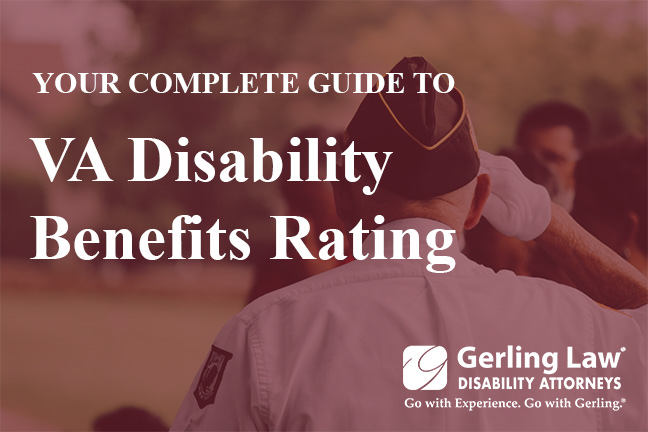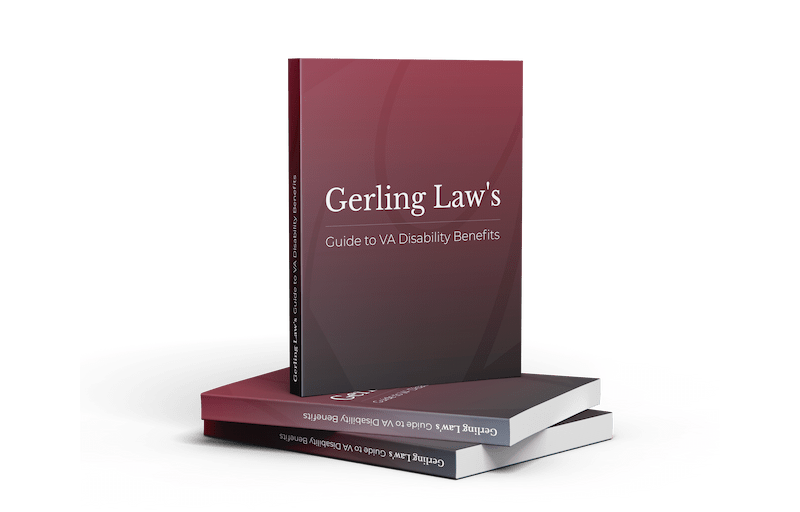
If you have applied for VA disability benefits—or if you’re preparing to submit your claim—it is important for you to learn more about the VA disability rating and how it can affect your benefits.
In the processing of disability claims, the U.S. Department of Veterans Affairs (VA) determines this rating and uses it to calculate the value of your benefit payments. If it gets the rating wrong, you could receive significantly less compensation than you expect—and deserve.
The VA disability attorneys at Gerling Law Disability Attorneys work tirelessly for our veteran clients to help them get the benefits they deserve. We offer a no-cost, no-obligation consultation for veterans who hope to get their disability claim approved or who have encountered problems in the approval process.
What Is a VA Disability Benefits Rating?
In the simplest terms, your disability rating is the VA’s opinion of your degree of disability, ranging from 0% to 100%. We will look at how this number is calculated below, but even more important is how this rating is used to calculate your benefits. Each year, the VA publishes its official Veterans Disability Compensation Rates schedule. This schedule states clearly what your monthly benefits will be based on your disability rating and your dependent status.
For a disabled veteran with no dependents, monthly benefit payments based on disability rating are as follows.
- 10% $144.14
- 20% $284.93
- 30% $441.35
- 40% $635.77
- 50% $905.04
- 60% $1,146.39
- 70% $1,444.71
- 80% $1,679.18
- 90% $1,887.18
- 100% $3,146.42
As you can see, the difference between each rating can be significant. To understand how the VA arrives at these figures, we must consider how it calculates your rating. These amounts listed above for each percentage are subject to change thanks to Cost of Living Adjustments (COLA) which are evaluated once per year. If a COLA is implemented, the amount of benefits will increase.
How Is the Disability Rating Calculated?
The VA does not total all of the individual disability ratings together as one total rating. This means if a Veteran has a 50% rating for one condition and 40% for another, their rating would not total to 90%. On the combined rating scale, they would only be rated 70%.
The VA uses individuals known as rating authorities (or sometimes just “raters”) to calculate and assign disability ratings for veterans who have submitted a claim for benefits. These individuals are caseworkers who handle this responsibility for both the VA and the U.S. Department of Defense. Each disability is rated on a combined disability benefits rating scale.
Raters review your submitted documentation, including doctors’ reports, test results, correspondence, etc., and analyze the information to arrive at a diagnosis (or diagnoses, if you suffer from multiple conditions). Each condition is assigned a diagnostic code.
Rating authorities then look up each diagnostic code in the Veteran Affairs Schedule for Rating Disabilities, or VASRD. Each diagnostic code has been pre-assigned a percentage of disability. For example, the VASRD assigns an applicant who has had heart valve replacement surgery a 100% disability rating for an indefinite period after hospital admission. An applicant who suffers from a peripheral vestibular disorder with dizziness and occasional staggering would be assigned a rating of 30%, whereas someone with recurrent tinnitus would be assigned a rating of only 10%.
The challenges of the VASRD pre-assigned ratings, however, is that few disabled veterans have a single, chronic medical condition that is so easily quantified. If you suffer from a variety of conditions, or if your condition isn’t specifically outlined in the VASRD, rating authorities have to make decisions on their own. In that case, ratings are assigned for each condition and then, using a complex set of formulas and calculations, averaged to establish your overall disability rating.
As you might imagine, the rating authorities’ decisions can be both subjective and inaccurate. And this can lead to you receiving a disability benefits rating that is lower than your actual level of disability.
How to Find My VA Disability Rating
You will be able to find your disability rating once the VA has rendered a decision about your claim application. This typically occurs within 90 days of submitting your benefits claim, although the process can take longer. Start by checking the status of your disability claim on www.VA.gov. If a decision has been made, you will be able to see each individual rating as well as your combined disability rating.
Because the dollar value of your monthly benefits is calculated directly from your disability rating, an incorrect rating can be devastating. You can appeal the VA’s decision on your benefits claim. Before you attempt that process, however, consider talking to an experienced veterans disability benefits lawyer to learn more about your options.
Contact a VA Disability Benefits Lawyer for Help
The VA disability claims attorneys of Gerling Law Disability Attorneys understand the importance of getting your benefits claim approved. However, we also understand how critical it is to get your disability rating right.
As a nationwide veterans disability benefits law firm, we can assist our client’s located anywhere in the U.S. If you are a United States Military Veteran or family member of a veteran living in another country other than the United States, you can still have your claim evaluated by our experienced VA disability attorneys. Your consultation is free, and you won’t owe any legal fees unless we get your benefits approved. Call us now at 1-888-GERLING (866-681-3919) to learn more about how our compassionate, experienced attorneys can help you. You can also contact us online to request help with your VA disability rating or benefits claim.
Basic Rates for Monthly Payments
| Dependent Status | 30% disability rating (in U.S. $) | 40% disability rating (in U.S. $) | 50% disability rating (in U.S. $) | 60% disability rating (in U.S. $) |
| Veteran alone (no dependents) | 441.35 | 635.77 | 905.04 | 1,146.39 |
| With spouse (no parents or children) | 493.35 | 705.77 | 992.04 | 1,251.39 |
| With spouse and 1 parent (no children) | 535.35 | 761.77 | 1,062.04 | 1,335.39 |
| With spouse and 2 parents (no children) | 577.35 | 817.77 | 1,132.04 | 1,419.39 |
| With 1 parent (no spouse or children) | 483.35 | 691.77 | 975.04 | 1,230.39 |
| With 2 parents (no spouse or children) | 525.35 | 747.77 | 1,045.04 | 1,314.39 |
Source: https://www.va.gov/disability/compensation-rates/veteran-rates/


